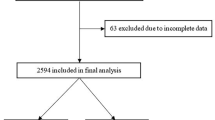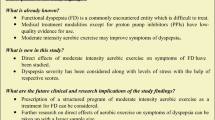Abstract
Background
Epidemiological data on the prevalence of uninvestigated dyspepsia (UD) and its impact on the health-related quality of life (HRQOL) in Indonesian population are still lacking. There is no study investigating the association between exercise and the HRQOL in UD patients. We aimed to investigate the prevalence of UD and its association with physical exercise, and its impact on HRQOL in Indonesian patients with UD.
Methods
This was a population-based, cross-sectional study, conducted using an internet-based questionnaire which was randomly distributed throughout Indonesia using the social media. The questionnaire contained socio-demographic details, exercise levels, Rome III criteria for dyspepsia, and SF-NDI (Short Form-Nepean Dyspepsia Index). The frequency, duration, the intensity of exercise, and the classification of exercise according to ACSM (American College of Sports Medicine) were included in the assessment. The screening for UD was conducted using the Rome III criteria and the SF-NDI score was calculated to assess the HRQOL in patients with UD.
Results
A total of 2725 valid responses were collected. The overall prevalence of UD in the study was 49.75%. Multiple logistic regression analysis showed that gender (female) and lack of exercise were independently associated with UD (OR 2.07, 95% CI 1.74–2.47, p < 0.001 and OR 1.72, 95% CI 1.42–2.07, p < 0.001). The median SF-NDI score among 1295 UD subjects in non-exercising and exercising groups was 21.00 and 18.00 (p < 0.001), respectively.
Conclusion
This study demonstrated the prevalence of UD and the association between exercise and HRQOL among UD patients in Indonesia.

Similar content being viewed by others
References
Ford AC, Marwaha A, Sood R, Moayyedi P. Global prevalence of, and risk factors for, uninvestigated dyspepsia: a meta-analysis. Gut. 2015;64:1049–57.
Ghoshal UC, Singh R, Chang FY, et al. Epidemiology of uninvestigated and functional dyspepsia in Asia: facts and fiction. J Neurogastroenterol Motil. 2011;17:235–44.
Stanghellini V, Chan FKL, Hasler WL, et al. Gastroduodenal disorders. Gastroenterology. 2016;150:1380–92.
Aro P, Talley NJ, Agreus L, et al. Functional dyspepsia impairs quality of life in the adult population. Aliment Pharmacol Ther. 2011;33:1215–24.
Veldhuyzen Van Zanten S, Wahlqvist P, Talley NJ, et al. Randomised clinical trial: the burden of illness of uninvestigated dyspepsia before and after treatment with esomeprazole - results from the STARS II study. Aliment Pharmacol Ther. 2011;34:714–23.
Filipović BF, Randjelovic T, Ille T, et al. Anxiety, personality traits and quality of life in functional dyspepsia-suffering patients. Eur J Intern Med. 2013;24:83–6.
Min BH, Huh KC, Jung HK, et al. Prevalence of uninvestigated dyspepsia and gastroesophageal reflux disease in Korea: a population-based study using the Rome III criteria. Dig Dis Sci. 2014;59:2721–9.
Halder SLS, Locke GR, Talley NJ, et al. Impact of functional gastrointestinal disorders on health-related quality of life: a population-based case-control study. Aliment Pharmacol Ther. 2004;19:233–42.
Everhart JE, Ruhl CE. Burden of digestive diseases in the United States part I: overall and upper gastrointestinal diseases. Gastroenterology. 2009;136:376–86.
Moghimi-Dehkordi B, Vahedi M, Khoshkrood Mansoori B, et al. Economic burden of gastro-oesophageal reflux disease and dyspepsia: a community-based study. Arab J Gastroenterol. 2011;12:86–9.
Mahadeva S, Goh KL. Epidemiology of functional dyspepsia: a global perspective. World J Gastroenterol. 2006;12:2661–6.
Mahadeva S, Yadav H, Rampal S, et al. Ethnic variation, epidemiological factors and quality of life impairment associated with dyspepsia in urban Malaysia. Aliment Pharmacol Ther. 2010;31:1141–51.
Kachintorn U. Epidemiology, approach and management of functional dyspepsia in Thailand. J Gastroenterol Hepatol. 2011;26:32–4.
Simadibrata M, Abdullah M, Syam A, et al. Dyspeptic syndrome in urban population in Jakarta. Jakarta Indones J Gastroenterol. 2010;11:66–70.
Johannesson E, Simrén M, Strid H, et al. Physical activity improves symptoms in irritable bowel syndrome: a randomized controlled trial. Am J Gastroenterol. 2011;106:915–22.
Peters H, De Vries W, Vanberge-Henegouw G, Akkermans L. Potential benefits and hazards of physical activity and exercise on the gastrointestinal tract. Gut. 2001;48:435–9.
Galper DI, Trivedi MH, Barlow CE, et al. Inverse association between physical inactivity and mental health in men and women. Med Sci Sports Exerc. 2006;38:173–8.
Blumenthal J, Babyak MA, Doraiswamy PM, et al. Exercise and pharmacotherapy in the treatment of major depressive disorder. Psychosom Med. 2009;69:587–96.
Indonesia Internet Service Provider Association. Penetrasi & Perilaku Pengguna Internet Indonesia: Survei 2016. [Internet]. 2016. Available from: https://www.apjii.or.id/content/read/39/264/Survei-Internet-APJII-2016. Accessed 20 Sep 2020.
Garber CE, Blissmer B, Deschenes MR, et al. Quantity and quality of exercise for developing and maintaining cardiorespiratory, musculoskeletal, and neuromotor fitness in apparently healthy adults: guidance for prescribing exercise. Med Sci Sports Exerc. 2011;43:1334–59.
Ainsworth BE, Haskell WL, Whitt MC, et al. Compendium of physical activities: an update of activity codes and MET intensities. Med Sci Sport Exerc. 2000;32:S498–516.
Drossman DA, Corazziari E, Delvaux M, et al. Rome III: The Functional Gastrointestinal Disorders 3rd Edition. VA:Degnon Associates; 2006.
Arinton IG, Samudro P, Soemohardjo S. The Nepean Dyspepsia Index: translation and validation in Indonesian language. Indones J Gastroenterol Hepatol Dig Endosc. 2006;7:38–41.
Talley NJ, Verlinden M, Jones M. Quality of life in functional dyspepsia: responsiveness of the Nepean Dyspepsia Index and development of a new 10-item short form. Aliment Pharmacol Ther. 2001;15:207–16.
Farsakh N, Saadeh A, Rawshdeh M, Farsakh H. Dyspepsia in the general population in Jordan. Indian J Gastroenterol 2000;19:68–70.
Olmos JA, Pogorelsky V, Tobal F, et al. Uninvestigated dyspepsia in Latin America: a population-based study. Dig Dis Sci. 2006;51:1922–9.
Ghoshal UC, Singh R. Frequency and risk factors of functional gastro-intestinal disorders in a rural Indian population. J Gastroenterol Hepatol. 2017;32:378–87.
Aro P, Talley NJ, Ronkainen J, et al. Anxiety is associated with uninvestigated and functional dyspepsia (Rome III criteria) in a Swedish population-based study. Gastroenterology. 2009;137:94–100.
Zagari RM, Law GR, Fuccio L, et al. Epidemiology of functional dyspepsia and subgroups in the Italian general population: an endoscopic study. Gastroenterology. 2010;138:1302–11.
Seid A, Tamir Z, Demsiss W. Uninvestigated dyspepsia and associated factors of patients with gastrointestinal disorders in Dessie Referral Hospital, Northeast Ethiopia. BMC Gastroenterol. 2018;18:1–10.
Ghoshal UC, Gwee KA, Chen M, et al. Development, translation and validation of enhanced Asian Rome III questionnaires for diagnosis of functional bowel diseases in major Asian languages: a Rome foundation-Asian neurogastroenterology and motility association working team report. J Neurogastroenterol Motil. 2015;21:83–92.
Mak ADP, Wu JCY, Chan Y, et al. Dyspepsia is strongly associated with major depression and generalised anxiety disorder - a community study. Aliment Pharmacol Ther. 2012;36:800–10.
Stake-Nilsson K, Hultcrantz R, Unge P, Wengström Y. Changes in symptoms and lifestyle factors in patients seeking healthcare for gastrointestinal symptoms: an 18-year follow-up study. Eur J Gastroenterol Hepatol. 2013;25:1470–7.
Miwa H. Life style in persons with functional gastrointestinal disorders - large-scale internet survey of lifestyle in Japan. Neurogastroenterol Motil. 2012;24:464–71.
Tuteja AK, Talley NJ, Joos SK, et al. Abdominal bloating in employed adults: prevalence, risk factors, and association with other bowel disorders. Am J Gastroenterol. 2008;103:1241–8.
Matsuzaki J, Suzuki H, Masaoka T, et al. Influence of regular exercise on gastric emptying in healthy men: a pilot study. J Clin Biochem Nutr. 2016;59:130–3.
Koloski NA, Jones M, Walker MM, et al. Functional dyspepsia is associated with lower exercise levels: a population-based study. United Eur Gastroenterol J. 2020;8:577–83.
Kang SS, Jeraldo PR, Kurti A, et al. Diet and exercise orthogonally alter the gut microbiome and reveal independent associations with anxiety and cognition. Mol Neurodegener. 2014;9:1–12.
Costa RJS, Snipe RMJ, Kitic CM, Gibson PR. Systematic review: exercise-induced gastrointestinal syndrome—implications for health and intestinal disease. Aliment Pharmacol Ther. 2017;46:246–65.
Badan Pusat Statistik Indonesia (Central Bureau of Statistics of Indonesia. Umur dan Jenis Kelamin Penduduk Indonesia: Hasil Sensus Penduduk 2010. [Internet]. 2011. Available from: https://www.bps.go.id/publication/2012/05/23/443332cda01195db289146b6/um. Accessed 20 Sep 2020.
Author information
Authors and Affiliations
Contributions
IH and RP conceived and drafted the study design. IH, RP, WP, WMR, and FNK collected all data. IH, RP, TAY, and NPHL analyzed and interpreted the data. IH, RP, WP, FNK, and WMR prepared the manuscript draft. TAY and NPHL supervised and gave expert advice. All authors commented on drafts of the paper. All authors have approved the final draft of the manuscript. IH is the guarantor.
Corresponding author
Ethics declarations
Competing interests
IH, RP, WP, FNK, WMR, TAY, and NPHL declare that they have no competing interests.
Ethics statement
The study was performed conforming to the Helsinki declaration of 1975, as revised in 2000 and 2008 concerning human and animal rights, and the authors followed the policy concerning informed consent as shown on Springer.com.
Disclaimer
The authors are solely responsible for the data and the contents of the paper. In no way, the Honorary Editor-in-Chief, Editorial Board Members, the Indian Society of Gastroenterology, or the printer/publishers are responsible for the results/findings and content of this article.
Additional information
Publisher’s note
Springer Nature remains neutral with regard to jurisdictional claims in published maps and institutional affiliations.
Rights and permissions
About this article
Cite this article
Huang, I., Pranata, R., Pangestu, W. et al. The prevalence of uninvestigated dyspepsia and the association of physical exercise with quality of life of uninvestigated dyspepsia patients in Indonesia: An internet-based survey. Indian J Gastroenterol 40, 176–182 (2021). https://doi.org/10.1007/s12664-020-01113-z
Received:
Accepted:
Published:
Issue Date:
DOI: https://doi.org/10.1007/s12664-020-01113-z




